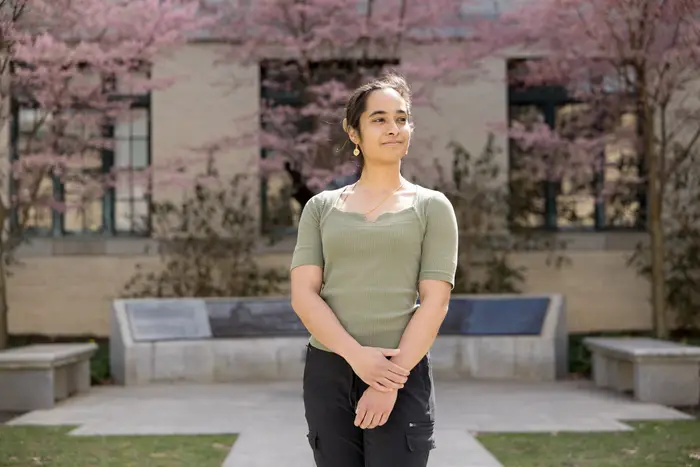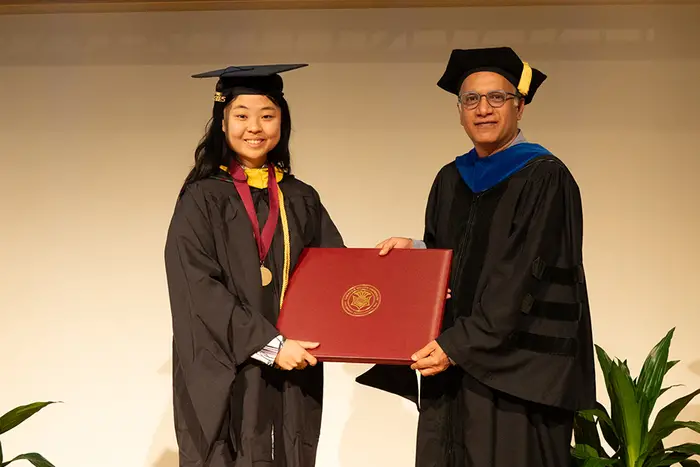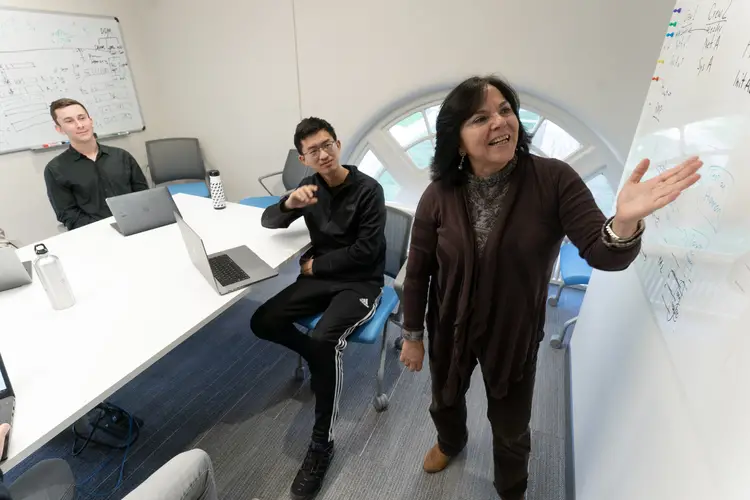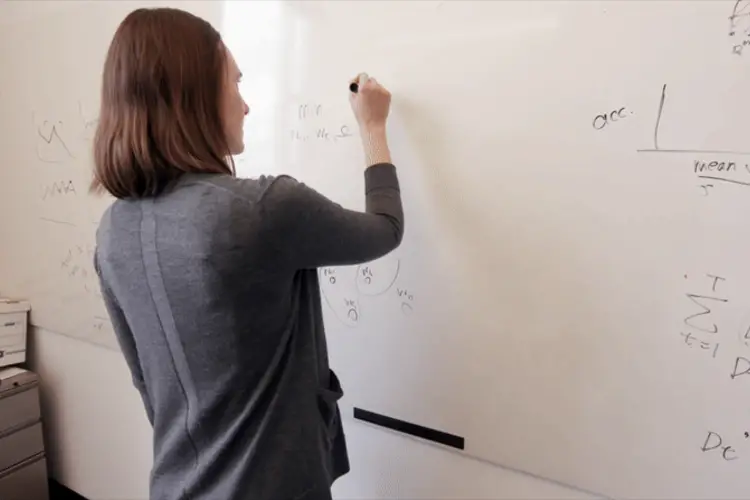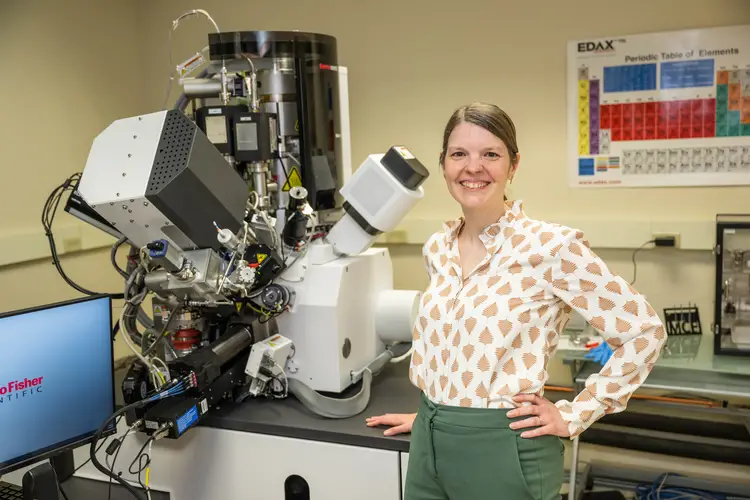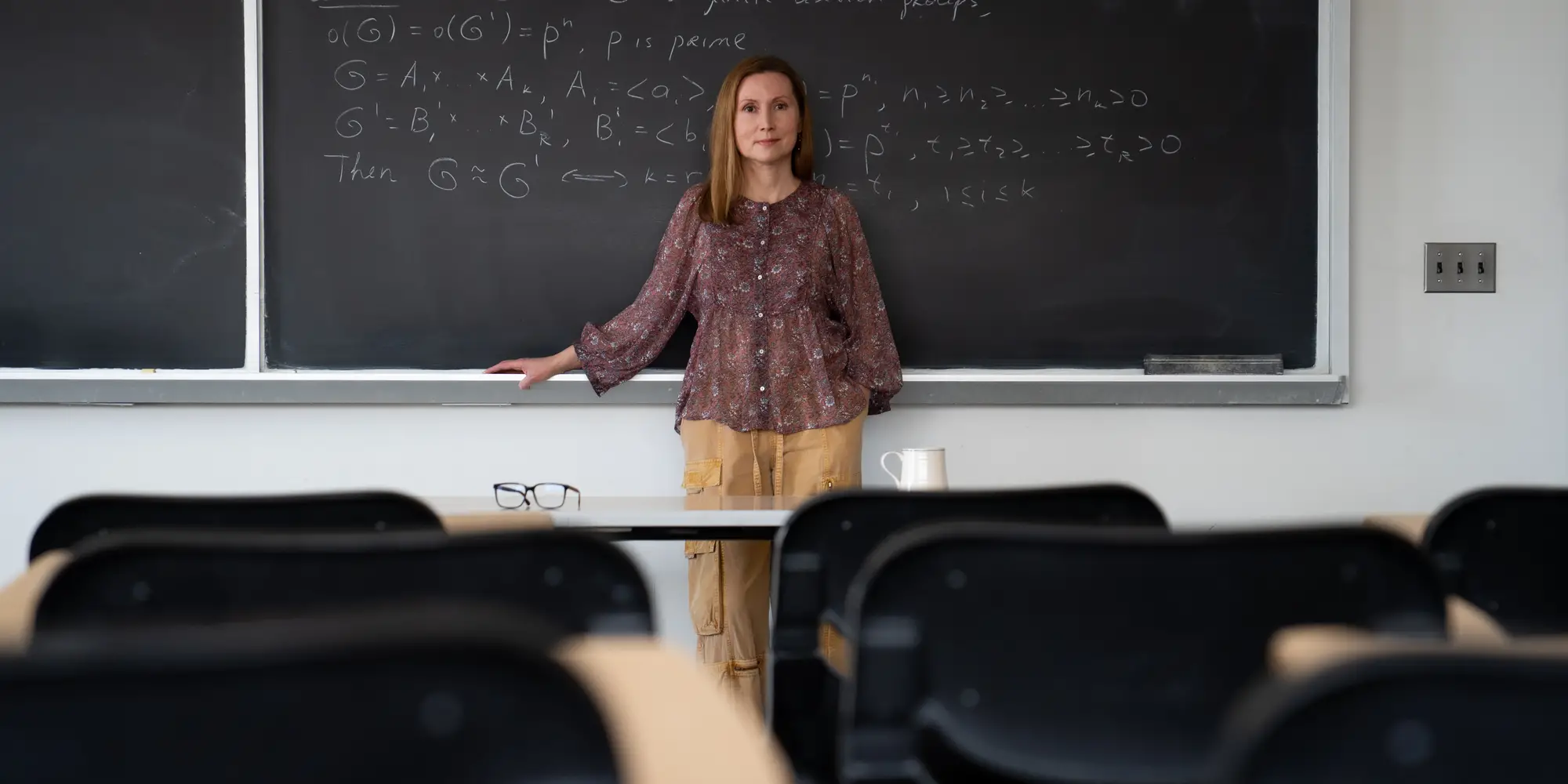
The Unexpected Art: How Women in Math Combine Calculation with Creativity
Media Inquiries
Carnegie Mellon University has a rich and extensive history in mathematics. 20th century advancements in the field(opens in new window) have set the stage for modern research in several areas of study.
From the work of interdisciplinary STEM leaders like Lenore Blum(opens in new window) to the ongoing work of Irene Fonseca(opens in new window) — a University Professor knighted by the military of Portugal for her work in Mathematics and named one of the most powerful women in business(opens in new window) — the historical achievements of women at CMU have left a lasting impression on the field.
Much of this work begins in the lab and the lecture hall before arriving on the world stage, and developments in mathematics happen at all levels of education and employment at Carnegie Mellon on a daily basis. From undergraduate study to graduate, postdoctoral and faculty research, women within the Mellon College of Science(opens in new window)’s Department of Mathematical Sciences are among those continuing the tradition.
Included in their ongoing contributions to teaching and research are inroads in subfields such as mathematical logic, set theory and combinatorics.
Alongside the goal of advancing their fields, they hope to encourage others to see math as a welcoming area of research that thrives on problem solving and creative thinking.
Irina Gheorghiciuc: Creating certainty from complexity
Irina Gheorghiciuc(opens in new window) is a teaching professor in CMU’s Department of Mathematical Sciences.
Born in Moldova, she came to the United States in 1998 to earn a Ph.D. in mathematics at the University of Pennsylvania (and, simultaneously, a master’s degree in computer science). She said that the field has always offered her a way to see the world in clear and certain terms.
"Some people appreciate randomness in mathematics. Some people do not. I am one of the people who do not," Gheorghiciuc said. "I like seeing the signs of something not being random, and understanding what exactly the pattern is, and why it is happening."
In keeping with this mindset, Gheorghiciuc's earlier research focused largely on a concept known as subword complexity, centered on the identification of unique sets of numbers that can appear in infinite sequences.
This concept extends to other areas of study as well, with several implications for computer science — a field underpinned by infinite strings of oft-recurring binary sequences. This brings a level of certainty to problems that can be never-ending in scope.
"Mathematics doesn't depend on what is happening in the human world. It is the same in China, in Russia, in America, in the Middle East, in Africa. It's exactly the same everywhere because it has its own rules," she said. "And that can be an anchor in trying times, I think both for humanity and for me personally."
In 2007, she came to CMU as assistant teaching professor. Many of the students in her courses come from across the university, including the College of Engineering(opens in new window), Tepper School of Business(opens in new window) and Dietrich College of Humanities and Social Sciences(opens in new window).
Much of the knowledge she passes on centers on finding patterns and trying familiar techniques amidst noise and uncertainty. She recalled playing chess with her father as a girl in Moldova.
"I remember the book that he was trying to teach me with. It was written by a Soviet grandmaster. This grandmaster's idea was that to learn how to play chess, one had to start with learning some basic closing positions with a few pieces left on the board, then some more complex ones with more pieces,” she said. “One learned to play chess "backward," from closing positions to opening positions. My father's attempt to teach me how to play chess failed comically. I displayed neither interest, nor patience. But that grandmaster's way of teaching this way stuck with me."
She said she wants to teach students similar tricks in mathematics.
“The idea is for the students to learn various arguments that appear in the proofs of different theorems and lemmas, and to then put them in their little bag of tricks," Gheorghiciuc said. "And once you have a big bag of tricks, it's very much about trying to trigger your memory. 'Have you seen it before? What did you do then? Maybe use one of those tricks. You don't know for sure that it will work, but you need to try.’"
Sumun Iyer: The joy of pure math
Sumun Iyer is an NSF-sponsored postdoctoral fellow at Carnegie Mellon. She began her research with faculty in the Department of Mathematical Sciences in fall of 2024.
Iyer attended Cornell University for her Ph.D., specializing in a field known as descriptive set theory.
"My research is very much in pure math," she said. "The questions are not coming from the world. Instead, they're coming internally from mathematics. But historically, for things that come from the realm of pure math, we may find applications decades later.
“The specific area that I work in is about very large spaces of symmetries. As an example, if you have something like a square, there's many ways that you have symmetries: You can flip it, you can turn it 90 degrees, you can keep turning it 180 degrees and so on. If you think for a little bit, you could conclude that there's not that many symmetries of the square and completely categorize them.”
The space of symmetries that Iyer works on are much larger than the collection of symmetries of the square. Studying these large spaces of symmetries can involve tools from topology and combinatorics.
“There's a lot of connections between my field, descriptive set theory, and other areas of math. I would love to see more of that, and have collaborations with people across fields so that we can share our tools,” she said.
The openness of pure math, Iyer said, can provide a satisfying outlet for problem solving, collaboration and creative thinking. But doing so requires a supportive environment and the right mindset.
"I feel like it's really important to have good teachers and mentors. I would not have gone into math without those people. It makes such a difference, especially early on, because it can really make or break how someone feels about math,” she said. “Do they think it's boring, terrible and stressful? Or do they think it's interesting, creative and open?"
Iyer said she has found it to be the latter, and she tries to impart the same feeling to others as a researcher and educator.
"The way people are taught math, it can come off as very cold — kind of like, 'Oh, this has been set in stone for like 300 years with axioms,'" Iyer said. "But when you're actually doing it, it's much more wiggly. There's a lot more trial and error: maybe something doesn't work, and you modify something, and then it works a little. Maybe it solves a problem that you didn't even know you had."
But some of the most rewarding tasks in mathematics, Iyer said, are finding joy and remembering the human element.
“Maybe even more important than anything to do with math itself is just finding people that you feel really comfortable with — whether it’s in your Ph.D. program or outside of it — so that you have social support.”
Sherry Sarkar: Allocation, optimization and the challenge of the perfect fit
Sherry Sarkar is a fifth-year Ph.D. student in the Algorithms, Combinatorics and Optimization program(opens in new window) (ACO) program at Carnegie Mellon. The ACO is a joint program between the Department of Mathematical Sciences, the Computer Science Department(opens in new window) and the Tepper School of Business' Department of Operations Management(opens in new window).
"There aren't very many colleges that will do a program like this," Sarkar said, citing her undergraduate alma mater, Georgia Institute of Technology, as one of the few others in North America. "Within the ACO program at Carnegie Mellon, it is the norm to branch out and work with professors in different departments. It's even normal to be advised by a professor in a different department," Sarkar said.
Sarkar said that the interdisciplinary nature of the ACO program, and of CMU as a whole, drew her to her current candidacy. Her research presently focuses on combinatorial optimization.
"For example, I'm at home and I want to get to campus. There's a complex network of roads outside. How do I get from point A to point B with this network?" she said. Problems like this allow her to pull on her experience in both mathematics and theoretical computer science.
"This is a canonical, classic problem in computer science — and it's very much a 'Google Maps' problem — but it's very close to the type of work that I do," Sarkar said. "It's very discrete, but if you think about the actual problems, they're fundamentally very geometric. You can phrase each one as a pure math problem and solve it with either combinatorial or continuous math techniques."
Another combinatorial optimization problem, known as the assignment/allocation problem, has a variety of applications in real-world contexts.
"You can find them in everyday situations," Sarkar said. "For example, there's the problem of assigning organ donors to recipients. Not every organ can be matched to every recipient, and there are restrictions based on what the recipient needs, or their blood type, or their location.
"The question is, what is the best way to allocate these resources to the people that need them? It's not just about donors and recipients. It can be used for everything from residency programs, to matching people to jobs, to dating apps."
A holistic approach to problem-solving is something that Sarkar is drawn to. Originally hailing from the Bay Area of California, Sarkar said a focus on technology and education has always been a part of her life.
"Growing up there, I feel like computer science and technology were part of my identity from a young age," she said. "I had a bit of a tumultuous relationship with math in high school — the culture around it was really competitive and that often seeped into my feelings for it — and I wasn't sure if I really liked it or not. But when I went into college, it was clear that math was already part of my identity."
Embracing this, she said, did not always come without challenge. Sarkar said that as a woman in a male-dominated field, it can be easy to feel excluded or overlooked, a feeling she encountered most often when stepping into academic environments for the first time.
“In any job or career, how you fit in with people has an effect on how you network, what you work on, and who's willing to work with you,” Sarkar said. “The math community has usually been very welcoming for me, but sometimes in more technical fields, people feel a little bit immune to this. They’ll say, ‘No, we're logical here. — the only thing that matters is the theorems we prove.’ I'm guilty of having thought that too before, but I don't think that's really true.”
Instead, implicit biases often play out in ways that can be difficult to recognize, let alone rectify.
“There are aspects of a person's identity — sometimes it's gender, but sometimes it's other things like socioeconomic background, where you went to undergrad, and so on — that can make a difference in what I might be able to achieve, or who's willing to work with me, or whether or not I'm accepted in certain circles.”
As a researcher and a lecturer, Sarkar tries to approach her own responsibilities with an inclusive mindset.
“The social aspect and how that affects you, how you do research, it can be both extremely powerful and extremely insidious, and navigating that can be difficult. So what I hope to do in my career is think critically about who is being brought in and who is being left out.
“I want to make sure everyone is part of the ingroup,” Sarkar said.
Francesca Yu: Finding home and completing the set
Francesca Yu is a senior in Carnegie Mellon's B.S. in Mathematical Sciences program(opens in new window). In high school, Yu developed an interest in the sciences, and she planned on majoring in physics when she first arrived at CMU. However, after completing her first year, she realized that she was interested more in the foundational principles driving her favorite subjects.
"During my studies, I encountered a lot of the fundamental questions of physics — ones that might appear to be more intuitive, but that I felt were unanswered during my study in physics. For instance, I gradually drove myself to read more on theoretical physics, and then I had more questions."
Since arriving at Carnegie Mellon, Yu has learned from past and present faculty members such as Clinton Conley(opens in new window), Aristotelis Panagiotopoulos(opens in new window) and Ernest Schimmerling(opens in new window).
"During projects I would talk to them about their respective fields, and then they would ask me so many thought provoking questions, and what I was curious about next," she said.
Learning directly from these professors and researchers helped her narrow her interest in mathematical studies even further, as she now holds an interest in the subfield of set theory, intending to pursue it as a focus of her graduate studies.
“Set theory is a field that's very young,” Yu said, “It has a short history, but it's an active research area where people try to push the limits.”
For Yu, the collaborative nature of mathematics and the presence of role models in the field has helped her thrive.
"People might perceive math to be some very talented people solving a crazy, open-ended problem by themselves, but that's a very stereotypical view. Math is extremely collaborative," she said. "Our math faculty is amazing. We talk about life just as much as we talk about math, and what I've learned is that math is never a solo effort."
Having found a home in a field of study she didn’t originally expect, she wants to help others think of math as a potential academic and career path.
“I want to encourage fellow students to come to math because it is beautiful,” she said. “Not just the work, but how it’s open to anyone. Regardless of your background, your values, anything — if you want to do it, you can do it. It's a small and tight community, but you get to know fascinating people. You get to think about things that feel exotic in nature. And it's an amazing feeling to talk to others about some of the most beautiful mathematical objects that are out there.”


